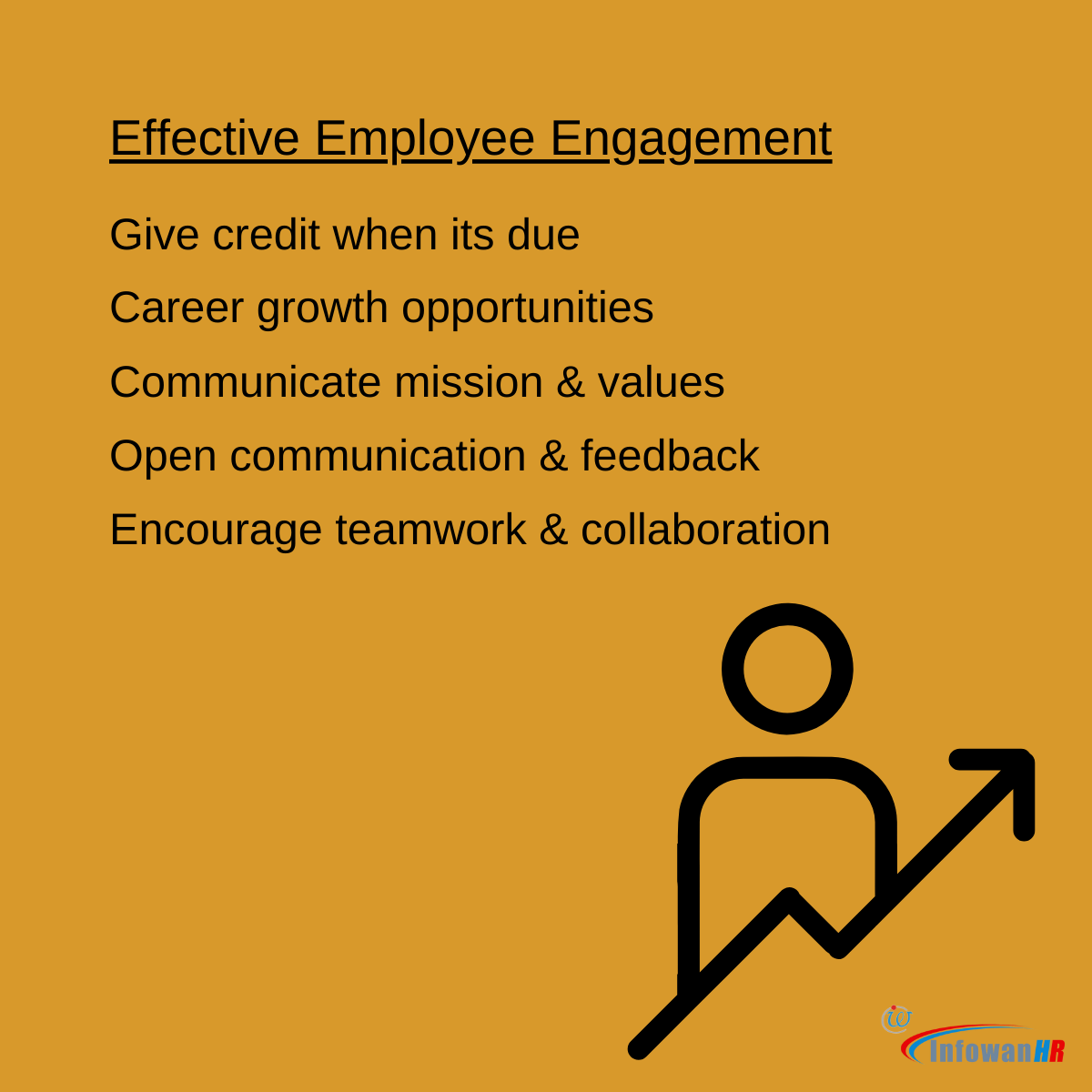
How can we help you today?
Registered Office
Infowan Technologies Pvt Ltd
Mumbai-401107. INDIA.
Contact Details
+91 98201 97205
+91 98201 26871
+91 98670 74415
support@infowan.net
info@infowan.net
|
Table of Contents
|
|---|
| Effective Employee Engagement |
| Designing an effective employee engagement strategy involves the following steps: |
| Managing employee engagement better |
| Employee Engagement Score: A Deeper Dive |
| Managing Employee Engagement with HRMS Software |
| Here's how HR manages employee engagement: |

Managing employee engagement in an organization is a multifaceted process that involves various strategies and initiatives. Engaged employees are more committed to their work, more productive, and less likely to leave their jobs. To achieve effective employee engagement, organizations should focus on creating a positive work culture, providing regular feedback and recognition, offering opportunities for growth and development, and promoting work-life balance. Additionally, involving employees in decision-making processes and fostering open communication can also contribute to their engagement and overall satisfaction. By prioritizing employee engagement, organizations can create a more productive, motivated, and successful workforce. Furthermore, HR software plays a very important role in employee management and increasing engagement. HRMS software can facilitate communication and collaboration between employees and managers.
Designing an effective employee engagement strategy involves the following steps:
• Develop and communicate a clear mission, vision, and values that employees can align with.
• Identify the key factors that drive employee engagement in your organization.
• Provide ongoing training and development opportunities to help employees grow and improve their skills.
• Regularly measure and assess employee engagement levels to track progress and identify areas for improvement.
• Give credit when credit is due. Celebrate successes and recognize employees for their contributions to the organization.
• Continuously evolve your employee engagement strategy to ensure it remains relevant and effective.
• Develop a plan that addresses these factors and aligns with your organization's goals and values.
By taking these steps, organizations can create an engaging work environment that fosters productivity, innovation, and success.
Managing employee engagement betterTo achieve effective employee engagement, a combination of strategies and initiatives are necessary. The HR department is crucial in creating and maintaining a culture of engagement, and the use of HR software can significantly enhance employee management and increase engagement. Implementing HRMS software can foster communication and collaboration between employees and managers, resulting in a productive and engaged workforce.
Employee Engagement Score: A Deeper DiveEffective Employee engagement is a crucial metric that reflects the emotional commitment and enthusiasm employees have toward their work, their colleagues, and the organization as a whole. A higher employee engagement score typically correlates with improved productivity, reduced turnover, and better overall business outcomes. Let's explore this metric in more detail:
1.
How to Calculate Employee Engagement Score:
•
Employee engagement is often measured through surveys and questionnaires. Common
questions include those related to job satisfaction, motivation, sense of belonging, and
willingness to recommend the company as a great place to work.
•
Responses are typically given on a scale, and the scores are aggregated to calculate an
engagement score.
2.
Components of Employee Engagement:
•
Employee engagement is multifaceted and can be broken down into several components:
A
Emotional Engagement:
The extent to which employees feel passionate, inspired, and motivated by their work.
B
Cognitive Engagement:
The level of intellectual involvement and commitment employees have toward their roles.
C
Behavioral Engagement:
Observable behaviors such as going above and beyond, willingness to
take on new challenges, and helping colleagues.
3.
Why Employee Engagement Matters:
•
Engaged employees are more likely to be satisfied with their jobs and are less likely to leave
the organization.
•
They tend to be more productive, creative, and innovative.
•
Engaged employees are often better advocates for the company, which can positively impact
the organization's reputation and recruitment efforts.
•
Higher engagement levels can lead to lower absenteeism and reduced workplace conflicts.
4.
Identifying Engagement Drivers:
•
Analyzing the components of employee engagement can help HR professionals identify specific
drivers of engagement within their organization.
•
Common drivers include effective leadership, opportunities for growth and development,
work-life balance, and recognition.
5.
Continuous Improvement:
•
Employee engagement is not a static metric. It requires ongoing attention and efforts to
maintain and improve.
•
HR professionals should regularly assess engagement levels, identify areas of concern, and
implement strategies to enhance engagement.
6.
Impact on Organizational Growth:
•
A high employee engagement score is often linked to improved business performance,
including increased profitability and customer satisfaction.
•
Engaged employees are more likely to align their efforts with the organization's strategic goals.
7.
Actionable Insights:
•
The insights gained from employee engagement surveys can guide HR strategies and
initiatives. For example, if the survey reveals that employees are dissatisfied with their growth
opportunities, HR can focus on implementing robust career development programs.

HR departments can leverage HRMS software to oversee employee engagement in an organization. By using features that track employee performance, recognition, and feedback, HR can obtain valuable insights into engagement levels. Employee surveys can also be created and handled through the software to gather feedback on engagement levels. HR can analyze the data collected to identify areas that require improvement and implement strategies accordingly. Additionally, the payroll HR software can be used as a platform for payroll processing, communication, and collaboration among employees, further enhancing engagement.
Here's how HR manages employee engagement:
1.
Conducting Employee Engagement Surveys:
•
HR typically administers regular engagement surveys to assess the overall mood of the
workforce. These surveys contain questions related to job satisfaction, workplace culture,
leadership effectiveness, and more.
•
The data collected helps HR understand the current state of engagement, identify trends, and
pinpoint areas that need improvement.
2.
Analyzing Survey Results:
•
HR professionals analyze the survey results to identify engagement drivers and areas of
concern. For example, if the data reveals that employees are dissatisfied with their work-life
balance, HR can focus on addressing this issue.
3.
Feedback and Action Planning:
•
HR collaborates with leadership to share survey results and gather feedback. Together, they
develop action plans to address the identified issues.
•
Action plans may include changes to policies, procedures, or initiatives aimed at enhancing
employee engagement.
4.
Communication and Transparency:
•
HR plays a pivotal role in ensuring open and transparent communication within the
organization. HR communicates survey results, action plans, and progress updates to
employees.
•
Transparency fosters trust and demonstrates that the organization values employee feedback.
5.
Leadership Development:
•
HR invests in leadership development programs to equip managers and supervisors with the
skills needed to engage and motivate their teams.
•
Effective leadership is a crucial driver of employee engagement.
6.
Recognition and Rewards Programs:
•
HR designs and implements recognition and rewards programs to acknowledge and celebrate
employee achievements.
•
These programs can boost morale and reinforce a culture of appreciation.
7.
Career Development Opportunities:
•
HR ensures that employees have access to opportunities for growth and development. This
includes training programs, mentorship, and pathways for advancement.
•
Clear career paths and opportunities for skill development are often key drivers of
engagement.
8.
Wellness and Work-Life Balance:
•
HR promotes employee well-being by offering wellness programs, mental health support, and
initiatives that promote work-life balance.
•
A healthy, balanced workforce is more likely to be engaged.
9.
Inclusion and Diversity Initiatives:
•
HR fosters diversity and inclusion within the organization. This includes implementing
initiatives that ensure all employees feel valued and respected, regardless of their
backgrounds.
10.
Feedback and Continuous Improvement:
•
HR encourages a culture of feedback, where employees are empowered to share their ideas
and concerns.
•
Regularly reviewing and updating engagement strategies is crucial for maintaining and
improving engagement levels.
11.
Measurement and Benchmarking:
•
HR continually monitors and measures engagement levels to assess the impact of its
initiatives.
•
Benchmarking against industry standards helps HR gauge the organization's relative
performance.
12.
Employee Resource Groups (ERGs):
•
HR supports the formation of ERGs, which provide employees with a sense of belonging and a
platform to share common interests and experiences.
Overall, In conclusion, HR experts utilize the Employee Engagement Score to evaluate and improve an organization's health. It reveals the workforce's emotional commitment and can help establish a more engaged, productive, and successful firm. HR's role in managing employee engagement is pivotal. By focusing on strategies that enhance workplace culture, leadership effectiveness, and employee well-being, HR helps create an engaged workforce that is motivated, productive and committed to the organization's success.